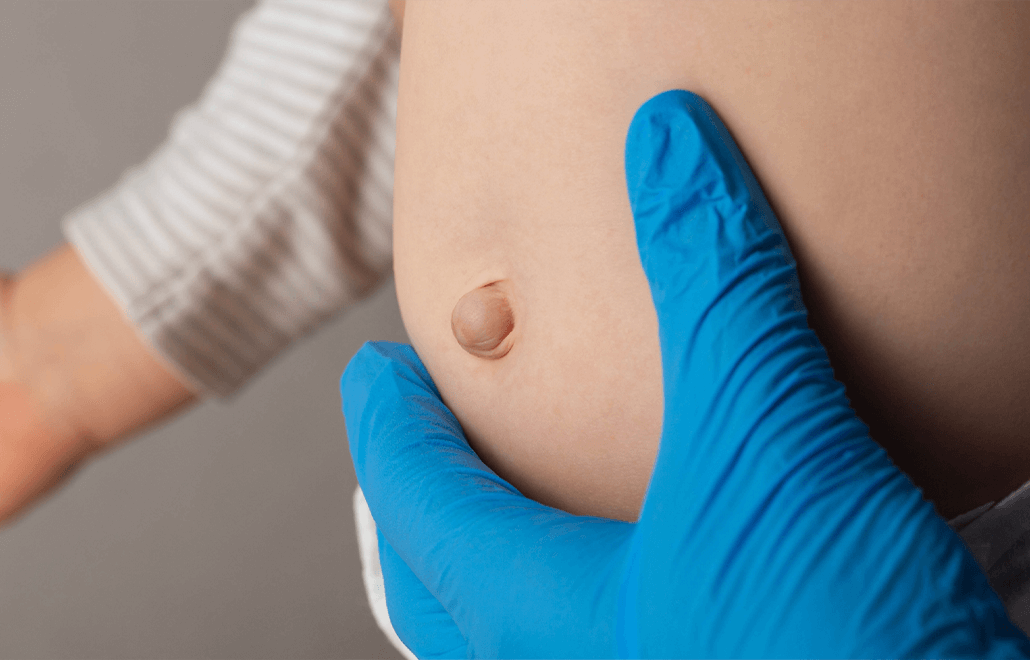
20 Feb Tiny Tummies, Big Questions: Exploring Umbilical Hernia Causes
3 min. readYour newborn’s arrival brings a whirlwind of joy and a myriad of new experiences. One of the common things you might notice is your baby’s belly button protruding slightly, raising questions about whether it’s normal or not. Rest assured, you’re not alone in pondering the mysteries of your tiny one’s tummy. In this article, we’re going to explore a phenomenon that can sometimes occur in infants: umbilical hernias.
What is an Umbilical Hernia?
An umbilical hernia is a condition in which the abdominal muscles don’t fully close around the belly button, leaving a small opening. This opening can allow a portion of the baby’s intestine or abdominal tissue to push through, causing a noticeable bulge near the navel. While this might sound alarming, umbilical hernias in infants are usually harmless and quite common.
Causes of Umbilical Hernias in Infants
Umbilical hernias in newborns and infants have various causes, and understanding them can help ease any concerns you may have:
- Incomplete Muscle Closure: During pregnancy, the abdominal muscles of the developing fetus don’t always close completely around the belly button area. This natural opening can persist after birth, leading to an umbilical hernia.
- Increased Intra-Abdominal Pressure: Certain actions, like crying, coughing, or straining during a bowel movement, can temporarily increase intra-abdominal pressure. This can push a portion of the intestine through the opening, causing the hernia to become more noticeable.
- Genetic Factors: Some babies may have a genetic predisposition to developing umbilical hernias, particularly if other family members have had them.
- Premature Birth: Premature infants often have weaker abdominal muscles, which can increase the likelihood of an umbilical hernia.
When to Seek Medical Advice
In most cases, umbilical hernias in infants are harmless and resolve on their own. However, there are situations where it’s essential to seek medical advice:
- Persistent Bulge: If the hernia doesn’t seem to be resolving on its own and remains large or becomes painful, it’s advisable to consult a pediatrician.
- Discoloration or Redness: If you notice any changes in the color or redness of the skin over the hernia, it could indicate a problem that needs medical attention.
- Vomiting or Refusal to Eat: If your baby experiences persistent vomiting or refuses to eat, it could be a sign that the hernia is causing complications.
Treatment and Monitoring
In most cases, no specific treatment is required for umbilical hernias in infants. Pediatricians will often recommend monitoring the hernia’s progress during regular check-ups. The majority of umbilical hernias close on their own as the child grows and the abdominal muscles strengthen.
Nurturing Healthy Tummies
While an umbilical hernia might raise questions for parents, it’s important to remember that they are usually a benign and common occurrence in infants. By understanding the causes and knowing when to seek medical advice, you can nurture your baby’s healthy tummy and watch it grow with confidence. As always, your pediatrician is your trusted partner in your child’s health journey, ready to address any concerns you may have along the way.
At Continuum Pediatrics, we’re here to provide guidance and support, so you can enjoy the beautiful moments of parenthood with peace of mind. Your baby’s tiny tummy is on its way to becoming a symbol of their strength and resilience.

